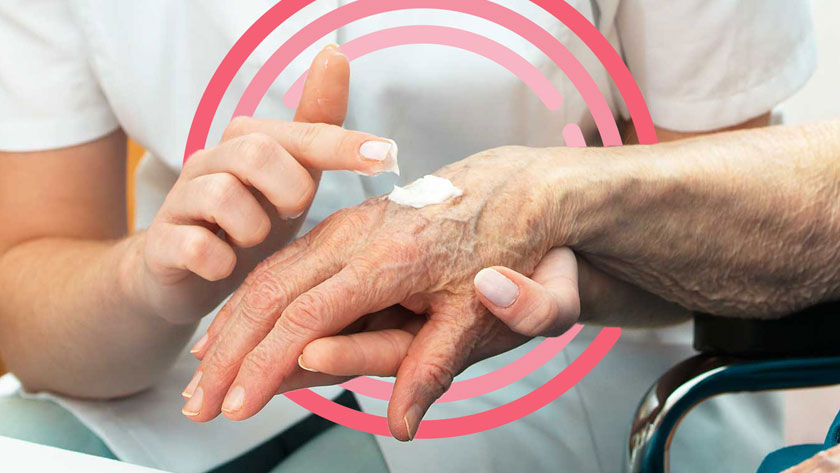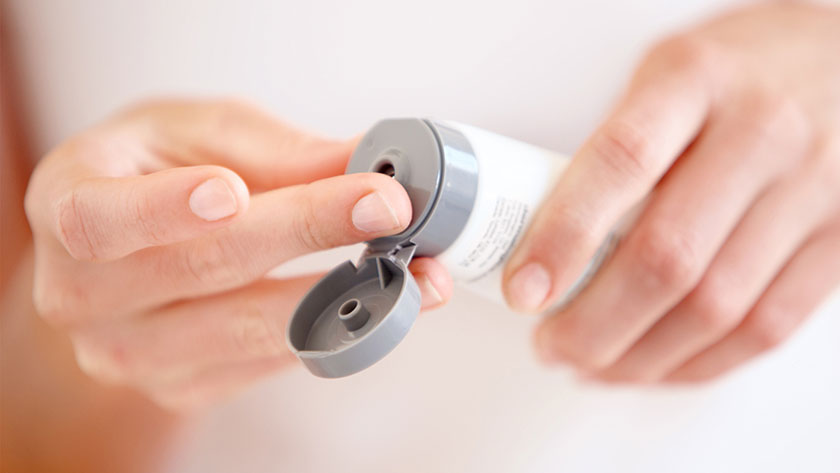Maintain skin integrity with 4 advanced skin care tools
Try these proven strategies to help improve overall skin outcomes.

Your everyday skin health routine for patients and residents includes cleansing, moisturizing and protecting the skin from pressure injury risk factors. In the past, this may have been accomplished with soap, water and basic moisturizers.
But soap can strip skin, leaving it dry, flaky and at higher risk of breakdown, especially for older adults. Traditional water baths may result in cold, dirty water; and simple moisturizers don’t offer a lot of long-term protection.
Let’s take a look at some of the scientifically proven ingredients and advanced skin care tools that can help you care for at-risk skin and help prevent skin breakdown.
Transform your practice with a 3-step skin care process
The skin is the largest organ of the body, so it’s important to have proven tools and strategies that empower your team to deliver the best care possible. Start with a process that reinforces evidence-based best practices.
- Better bathing. Gone are the days of bed baths using bath basins—an inconvenient and time-consuming method that is often uncomfortable for patients and can create an infection control issue as well. A complete bed or bedside bath can be given safely, inexpensively and comfortably with specially formulated products. For instance, instead of soap, consider a gentle, pH-balanced no-rinse cleansing foam or cleansing spray. These types of cleansers offer less mess because they cling to skin and make it easier to wipe off without irritating the skin. Plus, patients and residents will feel clean and refreshed without getting cold.
- More efficient moisturizing. Moisturizers seal in the body’s hydration and are particularly helpful in areas with low temperature and humidity, which can dry out the skin. The technical term for this is excessive transepidermal water loss (e-TEWL). Choose a nourishing moisturizer that includes dimethicone and leaves out ingredients known to cause adverse skin reactions, such as phthalates, dyes, aloe, parabens, sulfates and chemical fragrances.
- Build a barrier. When incontinence or wound exudate is an issue, skin barriers and protectants should be used. They provide a physical barrier between the skin and harmful body fluids and offer protection from breakdown. Look for a protectant with zinc oxide to create a thick, long-lasting barrier that stays in contact with the skin.
Feed the need: Skin care from the inside out
In its Clinical Practice Guideline, 2019, the National Pressure Injury Advisory Panel (NPIAP) emphasizes the vital role nutrition plays in preventing and treating pressure injuries. Ideally, individuals get their protein and nutrition from whole food sources. However, patients with pressure injuries frequently cannot meet their requirements from food alone. Those who are malnourished are at higher risk for further skin breakdown and prolonged healing times. There is also nutrient loss from the chronic wound. That’s why it’s essential to optimize protein and calorie intake. With proper nutrition assessments, individualized care planning, optimal nutrition intake and supplementation, clinicians can help effectively manage PIs.
Skin care research and development
The latest products use high-tech ingredients to benefit at-risk skin and help when skin is damaged. Here are some types of products to look for:
- Surfactant-free cleansers that use phospholipid technology to cleanse
- State-of-the-art moisturizers that contain oils such as jojoba seed oil that help replace epidemeral lipids
- Vitamins and proteins from natural sources such as soybeans and blue green algae
- Essential amino acids—the building blocks for protein and collagen production—including L-cysteine, L-proline and glycine
- High-tech barriers such as those containing complex silicones like cetyl dimethicone, cyclomethicone, cyclopentasiloxane and dimethicone copolymer
- Products free of parabens, phthalates, sulfates, dyes and chemical fragrances
- Moisturizers with ingredients such as oils, petrolatum and silicones help prevent transepidermal water loss (the greater the water loss, the more the skin’s barrier function is weakened)
The ultimate clinical goals of skin and wound care are to help prevent and treat skin integrity issues. It’s important to empower caregivers to follow best practices that help achieve those goals.
Products that work together work better
When it comes to preventing skin breakdown, it helps to choose products that are designed to be used together. Here are 4 reasons why:
- Systems of products are specially formulated to be used safely together. For instance, some antibacterial wicking sheets can be used with an antifungal powder or cream, while others are contraindicated.
- Streamlining product supply formulary reduces the risk of inappropriate products being selected off a busy or cluttered shelf. It’s all about the right product at the right time.
- Simplifying product options eliminates confusion and guesswork and helps you implement a skin care routine that sticks. The simple process becomes muscle memory for the caregiver, which leads to more efficient use of time and energy.
- Fewer product variables make it easier for caregivers to know what’s working on different areas of the skin and what’s not. That can help you prevent pressure injuries and avoid setbacks.
Key takeaway
Skin needs nourishment to help stay healthy. Choose gentle cleansers, moisturizers and barriers that contain proven ingredients to help strengthen skin and provide protection against skin breakdown. With the right tools and strategies, you can get a head start on skin health.




